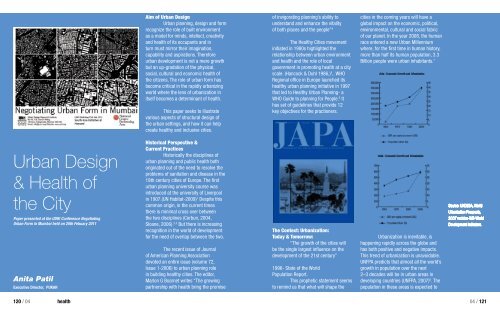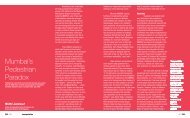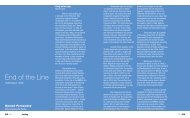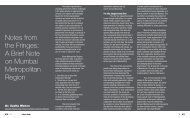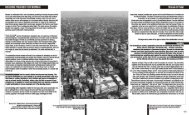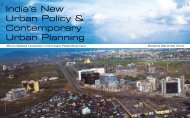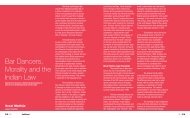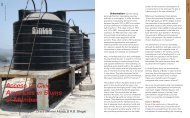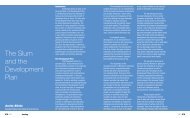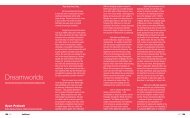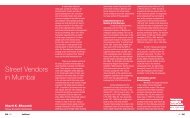Anita Patil - Urban Design & Health of the City
Anita Patil - Urban Design & Health of the City
Anita Patil - Urban Design & Health of the City
Create successful ePaper yourself
Turn your PDF publications into a flip-book with our unique Google optimized e-Paper software.
Aim <strong>of</strong> <strong>Urban</strong> <strong>Design</strong><strong>Urban</strong> planning, design and formrecognize <strong>the</strong> role <strong>of</strong> built environmentas a model for minds, intellect, creativityand health <strong>of</strong> its occupants and inturn must mirror <strong>the</strong>ir imagination,capability and aspirations. Thereforeurban development is not a mere growthbut an up-gradation <strong>of</strong> <strong>the</strong> physical,social, cultural and economic health <strong>of</strong><strong>the</strong> citizens. The role <strong>of</strong> urban form hasbecome critical in <strong>the</strong> rapidly urbanizingworld where <strong>the</strong> lens <strong>of</strong> urbanization initself becomes a determinant <strong>of</strong> health.This paper seeks to illustratevarious aspects <strong>of</strong> structural design <strong>of</strong><strong>the</strong> urban settings, and how it can helpcreate healthy and inclusive cities.<strong>of</strong> invigorating planning’s ability tounderstand and enhance <strong>the</strong> vitality<strong>of</strong> both places and <strong>the</strong> people” 4The <strong>Health</strong>y Cities movementinitiated in 1980s highlighted <strong>the</strong>relationship between urban environmentand health and <strong>the</strong> role <strong>of</strong> localgovernment in promoting health at a cityscale. (Hancock & Duhl 1986,) 5 ,. WHORegional <strong>of</strong>fice in Europe launched itshealthy urban planning initiative in 1997that led to <strong>Health</strong>y <strong>Urban</strong> Planning- aWHO Guide to planning for People. 6 Ithas set <strong>of</strong> guidelines that provide 12key objectives for <strong>the</strong> practioners.cities in <strong>the</strong> coming years will have aglobal impact on <strong>the</strong> economic, political,environmental, cultural and social fabric<strong>of</strong> our planet. In <strong>the</strong> year 2008, <strong>the</strong> humanrace entered a new <strong>Urban</strong> Millenniumwhere, for <strong>the</strong> first time in human history,more than half its human population, 3.3Billion people were urban inhabitants. 7<strong>Urban</strong> <strong>Design</strong>& <strong>Health</strong> <strong>of</strong><strong>the</strong> <strong>City</strong>Paper presented at <strong>the</strong> UDRI Conference Negotiating<strong>Urban</strong> Form in Mumbai held on 25th Febuary 2011<strong>Anita</strong> <strong>Patil</strong>Executive Director, PUKARHistorical Perspective &Current PracticesHistorically <strong>the</strong> disciplines <strong>of</strong>urban planning and public health bothoriginated out <strong>of</strong> <strong>the</strong> need to resolve <strong>the</strong>problems <strong>of</strong> sanitation and disease in <strong>the</strong>19th century cities <strong>of</strong> Europe. The firsturban planning university course wasintroduced at <strong>the</strong> university <strong>of</strong> Liverpoolin 1907.(UN Habitat-2009) 1 Despite thiscommon origin, in <strong>the</strong> current times<strong>the</strong>re is minimal cross over between<strong>the</strong> two disciplines (Corbun, 2004,Sloane, 2006). 2,3 But <strong>the</strong>re is increasingrecognition in <strong>the</strong> world <strong>of</strong> developmentfor <strong>the</strong> need <strong>of</strong> overlap between <strong>the</strong> two.The recent issue <strong>of</strong> Journal<strong>of</strong> American Planning Associationdevoted an entire issue (volume 72,Issue 1-2006) to urban planning rolein building healthy cities. The editor,Marlon G Boarnet writes “The growingpartnership with health bring <strong>the</strong> promiseThe Context: <strong>Urban</strong>ization:Today & Tomorrow:“The growth <strong>of</strong> <strong>the</strong> cities willbe <strong>the</strong> single largest influence on <strong>the</strong>development <strong>of</strong> <strong>the</strong> 21st century”1996- State <strong>of</strong> <strong>the</strong> WorldPopulation Report.This prophetic statement seemsto remind us that what will shape <strong>the</strong><strong>Urban</strong>ization is inevitable, ishappening rapidly across <strong>the</strong> globe andhas both positive and negative impacts.This trend <strong>of</strong> urbanization is unavoidable.UNFPA predicts that almost all <strong>the</strong> world’sgrowth in population over <strong>the</strong> next2–3 decades will be in urban areas indeveloping countries (UNFPA, 2007) 8 . Thepopulation in <strong>the</strong>se areas is expected toSource: UNDESA, World<strong>Urban</strong>ization Prospects,2007 revision-WB-WorldDevelopment Indicators.120 / 04 health04 / 121
Share <strong>of</strong> national gdp andpopulation <strong>of</strong> selected citiesSources: Van Dijk, 2007.Johannesburg, Cape Town:Naude & Krugell, 2004.grow from 2 billion in 2000 to 3.9 billionin 2030, while <strong>the</strong> total world populationmay grow from 6 to 8 billion, with <strong>the</strong>most rapid pace <strong>of</strong> growth expectedin Asia and Africa.(UN Habitat, 2006) 9While North America, Latin America andEurope are currently <strong>the</strong> most urbanizedregions, <strong>the</strong> number <strong>of</strong> urban dwellersin <strong>the</strong> least urbanized region, Asia (1.8billion), is already greater than that inNorth America, South America, Japanand Europe combined (1.3 billion).An outstanding feature <strong>of</strong> <strong>the</strong>urban population growth in 21st centuryis that it will be composed <strong>of</strong> poor people.One out <strong>of</strong> every three, city dwellersnearlyone billion people - lives in aslum. Most <strong>of</strong> <strong>the</strong> slum dwellers in SouthAsia, 63% or almost 170 Million people,reside in India. (UN Habitat-2009) 10Role <strong>of</strong> CitiesCities have traditionallybeen <strong>the</strong> engines <strong>of</strong> growth since <strong>the</strong>industrialization began. The prosperity<strong>of</strong> nation is intimately linked to <strong>the</strong>prosperity <strong>of</strong> <strong>the</strong>ir cities. (UN Habitat2010-2011). 11 In this sense, urbanization,in a way similar to globalization, can beseen as a structural social determinant <strong>of</strong>health that can challenge <strong>the</strong> aspirations<strong>of</strong> equity due to <strong>the</strong> tendency foraccumulation <strong>of</strong> wealth and power among<strong>the</strong> urban elite (Vlahov et al., 2007) 12On one hand cities have become<strong>the</strong> engines <strong>of</strong> growth, encompassinga large pool <strong>of</strong> talent, finance, labourand knowledge creation opportunitiesin concentrated areas, thus producingeconomies <strong>of</strong> scale. On <strong>the</strong> o<strong>the</strong>rhand <strong>the</strong>y have also become places <strong>of</strong>increasing poverty, disparity, squalor andsocial disruption. Inequalities in <strong>the</strong> intracityaccess to services, housing, healthand health care, education & employmenthave socio-economic, environmentaland political repercussions. The realchallenge lies in recognizing flaws <strong>of</strong> <strong>the</strong>process and find solutions that will make<strong>the</strong> positive impacts more pronounced,<strong>the</strong> growth more inclusive and equitableand prevent and / or reduce <strong>the</strong> negativeimpact <strong>of</strong> this unprecedented growth.<strong>Urban</strong>ization <strong>of</strong> Poverty& Planet <strong>of</strong> SlumsIndustrialization, urbanizationand associated migration have influenced<strong>the</strong> land use patterns in all cities andland has become <strong>the</strong> most precious andcontested commodity. This is especiallytrue in an island city <strong>of</strong> Mumbai, thusmaking Mumbai one <strong>of</strong> <strong>the</strong> mostexpensive real estate markets in <strong>the</strong>world. This has resulted in <strong>the</strong> growth<strong>of</strong> slums due to rapid growth <strong>of</strong> <strong>the</strong>population and <strong>the</strong> failure <strong>of</strong> <strong>the</strong> citiesto provide <strong>the</strong> necessary infrastructure,land and low cost housing to <strong>the</strong>marginalized sector. Cities as diverse asNairobi, Johannesburg, Mexico, Rio andMumbai have large number <strong>of</strong> residentsliving in slums. The slum population<strong>of</strong> Rio is almost <strong>the</strong> same as <strong>the</strong> totalpopulation <strong>of</strong> Helsinki (State <strong>of</strong> <strong>the</strong> WorldCities 2007) 13 Mumbai’s more than 6million slum dwellers exceed <strong>the</strong> totalpopulation <strong>of</strong> Nairobi. These 6 millionoccupy a total <strong>of</strong> 8% land <strong>of</strong> Mumbaithus creating a density <strong>of</strong> 29,650 peopleper square kilometer compared to 2050per square kilometer <strong>of</strong> New York.Definition <strong>of</strong> slums differsfrom country to country and city-to-city<strong>the</strong>refore <strong>the</strong> exact number <strong>of</strong> peopleliving in <strong>the</strong> slums in any country isdifficult to estimate. The operationaldefinition <strong>of</strong> slum as per <strong>the</strong> UN Habitatis as follows: A slum is a group <strong>of</strong>individual living under a same ro<strong>of</strong> inan urban area who LACK one or more<strong>of</strong> <strong>the</strong> following five conditions1. Durable Housing2. Sufficient Living Area3. Access to Improved water4. Access to sanitation5. Secure TenureVarious Dimensions <strong>of</strong> <strong>Urban</strong> Poverty• Poor quality, hazardous, overcrowdedand <strong>of</strong>ten insecure housing• Inadequate provision <strong>of</strong> basicservices which increases <strong>the</strong> healthburden and <strong>the</strong> work burden• Inadequate, unstableor risky asset base• Inadequate public infrastructuresuch as schools, and hospitals• Limited or No safety nets• Inadequate protection <strong>of</strong> rightsthrough <strong>the</strong> operation <strong>of</strong> <strong>the</strong> law• Voiceless-ness and powerlessnesswithin <strong>the</strong> non-responsive politicalsystem and bureaucratic structure.(Adopted from Satterthwaite 2004)The annual growth rate<strong>of</strong> cities and slumssource: UN-HAbitat, GLobal<strong>Urban</strong> Observatory 2004.122 / 04 health04 / 123
<strong>Urban</strong> <strong>Design</strong> & <strong>Health</strong>“The urban setting is a lensthat magnifies or diminishes o<strong>the</strong>rsocial determinants <strong>of</strong> health. <strong>Urban</strong>environments have a number <strong>of</strong>contextual and compositional attributessuch as size, density, complexity andverticality that affects health equity inboth positive and negative ways.” KNUS14While social and economic conditionsare vitally important, <strong>the</strong>re is a growingbody <strong>of</strong> work across <strong>the</strong> disciplines thatrecognize <strong>the</strong> role <strong>of</strong> physical urbanenvironment in shaping health anddiseases and thus in contributing tohealth equities (Galea & Vlaho 2005 ) 15Visible and invisible spatialborders that transpire into segregation<strong>of</strong> <strong>the</strong> society according to socioeconomicconditions <strong>of</strong>ten divide cities.According to UN Habitat 2010‐2011,‘Closer assessment <strong>of</strong> <strong>the</strong>urban space in many cities <strong>of</strong> <strong>the</strong>developing world unambiguouslyexposes <strong>the</strong> fragmentation <strong>of</strong> <strong>the</strong>society with clear differences in <strong>the</strong> wayspace and opportunities are produced,appropriated, transformed and used’.Some areas features significantinfrastructure, well kept parks, gardensand clean well built residential areas. Incontrast, o<strong>the</strong>r areas are characterizedby sever deprivation, inadequate housingdeficient services, poor recreationaland cultural facilities, urban decay andscarce capital expenditure. This kind<strong>of</strong> spatial injustice has tremendousimpact on <strong>the</strong> health <strong>of</strong> <strong>the</strong> residents.It is in this context that <strong>the</strong> urbandesign has a critical role to play.<strong>Urban</strong> planning and design orlack <strong>of</strong> it can create very different urbanenvironments that can impact health in apositive or negative way. In all countriespoor end up living in unhealthy places…down stream, down wind, in low layinglands, in flood plains, in landslides, overgarbage dumps, near polluting factories.In <strong>the</strong> city <strong>of</strong> New York all <strong>the</strong> bus depotsare located in Harlem, where <strong>the</strong> AfricanAmerican people are concentrated.Most slum dwellers inMumbai are located along <strong>the</strong> railwaytracks, over <strong>the</strong> dumping grounds,or near flooding areas. It has beennoted that ‘Disparities in health areincreasingly linked to <strong>the</strong> physical andsocial environment that fall under <strong>the</strong>domain <strong>of</strong> planning (Corburn 2004)The issue that can be moderatedthrough urban design and planning:Land use patters, designing<strong>of</strong> infrastructures, both s<strong>of</strong>t and hard,density and location <strong>of</strong> facilities and safeneighbourhoods. Availability or lack <strong>of</strong>this has severe impact on <strong>the</strong> physicaland mental health <strong>of</strong> <strong>the</strong> residents.<strong>Urban</strong> planning and <strong>the</strong>regulatory framework it provides on landuse, land development, housing andbuilding standards and infrastructurestandards should reduce inequities inliving conditions. Their core purpose is toensure health and safety, including landuseregulations that prevent buildingson unsuitable sites (for instance, floodplains), and ensure that land is availablefor infrastructure and services and open/public space (Barton & Tsouros, 2000) 16 .Six pathways for designinghealthy cities1. Equitable Access toBenefits <strong>of</strong> <strong>Urban</strong> life:Assess to livelihood opportunitiesare critical to people’s health. Longand expensive commute to workingplace and lack <strong>of</strong> easy access totransportation impact both <strong>the</strong> physicaland <strong>the</strong> economic conditions <strong>of</strong> <strong>the</strong>family and makes urban poor vulnerableto unemployment. Spatial mismatchbetween job location and place <strong>of</strong>residence can leave more remote slumdwellers little alternative but to spenda night in public space, squat in <strong>the</strong>temporary unit devoid <strong>of</strong> services. In Riosome workers sleep on benches duringweek saving commuting time as wellas transportation costs that consume20% <strong>of</strong> <strong>the</strong>ir earnings. In Mexico city20 % <strong>of</strong> workers spend more than 3hours commuting to and from workeveryday. (State <strong>of</strong> World cities 2010/11)In an affluent country like US,traffic congestion cost $ 4.27 Billion inextra fuel and person hours in Chicagoin 2003 (<strong>Urban</strong> Mobility Report, TexasTransportation Institute). On <strong>the</strong> o<strong>the</strong>rhand Victoria Transport Policy in Australiastates that public transit in cities cansave $279 per capita in congestions costsavings. This identifies <strong>the</strong> importance<strong>of</strong> infrastructure. (GRNUHE) 17Traffic accidents are also on<strong>the</strong> rise in <strong>the</strong> cities. Between 1975-1998 traffic fatalities increased by237.1 % in Columbia, 243 % in Chinaand 338% in Botswana. Many who diein traffic accidents are pedestrians.In Mumbai where 6.5 million workerstravel on <strong>the</strong> commuter trains, 19persons are killed each day in trainrelated accidents (Uncovering <strong>the</strong>Myth <strong>of</strong> <strong>Urban</strong> Development inMumbai’ by Dr. S. Parasuraman) 18 .Better urban infrastructure,pedestrian friendly streets and wellplanned transport system that providesafe options for getting around <strong>the</strong>city are needed to curb <strong>the</strong> rise in<strong>the</strong> traffic Deaths (UN Habitat, State<strong>of</strong> <strong>the</strong> World’s Cities, 2006/7).O<strong>the</strong>r critical access is for <strong>the</strong>health care services and facilities. In poorareas <strong>the</strong>re are no health care facilitiesavailable. In Kaula Bandar, a 40 years oldunregistered slum in Mumbai PUKAR hasfound out that <strong>the</strong>re is no primary schoolin this community <strong>of</strong> 15000-18000 peopleand <strong>the</strong> nearest health service deliveryfacility is 1.5 kms away with no publictransportation available to reach thatfacility. (June 2010 Report to RockefellerFoundation, Unpublished data). Researchin higher income countries has revealedthat in densely populated cities <strong>the</strong>124 / 04 health04 / 125
esponse time <strong>of</strong> <strong>the</strong> emergencyambulances and fire services is very long,leading to lower survival rates. (Campbellet al. 1993,) 19 , In Mumbai, <strong>the</strong>re is n<strong>of</strong>acility for a special ambulance lane andno traffic system existent for making wayfor an ambulance. (personal observations).Access to schools,community places and parks arealso important for communitycohesions and physical activities.2. Access to adequate housingThe link between health andhousing has been known for centuries.Vast body <strong>of</strong> literature has explored <strong>the</strong>connections between housing and healthimpacts. (Thomson, Petticrew 2002). 20Most <strong>of</strong> <strong>the</strong> major cities in <strong>the</strong>world have been facing <strong>the</strong> constantcrisis <strong>of</strong> lack <strong>of</strong> affordable housingfor <strong>the</strong> urban poor and increasinghealth inequities created by <strong>the</strong>lack <strong>of</strong> shelter in <strong>the</strong> urban poor.The <strong>Health</strong> Evidence Network,Europe produced a report in Feb. 2005‘Is Housing Improvements apotential health improvement strategy?’The summery <strong>of</strong> that reportssays- “The well-established links betweenpoor health, poor housing and povertysuggest that housing improvements indisadvantaged areas or social housingmay provide a population-based strategyto improve health and reduce healthinequalities. Housing improvements thatreduce exposure to specific hazardsmay lead to health improvements forcurrent residents and prevent harmfulexposure by future generations”Smith’s study in 1989 21delineated specific health conditions thatarise from poor housing structures, anarea deeply related to urban design:Each <strong>of</strong> <strong>the</strong>se factorscan be addressed by changing <strong>the</strong>structural design even within <strong>the</strong>restrains <strong>of</strong> <strong>the</strong> costs, material andland use by creative means.The world <strong>Health</strong> Organizationhas identified nine critical features<strong>of</strong> housing conditions that canhave direct impact on health.1. The house as structure that protectsoccupants from natural elements likeheat, cold, rains flood, pests, noise, etc.2. The extent to which <strong>the</strong>reis adequate water supply, bothquantitative and qualitative3. The effectiveness <strong>of</strong> <strong>the</strong> provision forexcreta, sewage and solid waste disposaland management <strong>of</strong> that disposal4. The quality <strong>of</strong> housing site, <strong>the</strong>extent to which it is structurally safefor <strong>the</strong> housing and <strong>the</strong> extent towhich provision is made to protectit from contamination.(provision fordrainage being <strong>the</strong> most important)5. Effects associated with overcrowdingincluding household accidents, increasedamount <strong>of</strong> air‐born infectious diseasesincluding pneumonia and TB.6. Indoor air pollution associated withfuels used for cooking and heating7. Food safety including <strong>the</strong> extent towhich <strong>the</strong> shelter had adequate provision8. Vectors and hosts <strong>of</strong> o<strong>the</strong>r diseasesassociated with <strong>the</strong> domestic andperidomestic environment.9. Home as a workplace‐ whereoccupational health questions suchKaula Bandar: Anunregistered slumin Mumbai- Lack <strong>of</strong>water, sanitation &garbage disposal:- PUKAR-HSPH-NYU Project.Housing DefectsInadequate heatingInadequate ventilationLack <strong>of</strong> Hygiene FacilityInadequate kitchen facilityDisrepairStructural instabilityInadequate lightingUse <strong>of</strong> hazardous materialsOvercrowdingInadequate means <strong>of</strong> escapesource: UN-HABITAT, Global <strong>Urban</strong> Observatory 2004.<strong>Health</strong> RisksBronchitis, PneumoniaHeart disease, hypo<strong>the</strong>rmia,Accidents, Dampness with growth <strong>of</strong> mouldsRespiratory diseases, CO poisingInfectious diseasesAccidents, food poisoningAccidents, Fires, InfectionsAccidentsAccidentsCancer and respiratory diseasesInfections, stress, Intra‐family violenceInjury or death by fireKaula Bandar: Anunregistered slumin Mumbai- homeas a work place11 child labourers workingand living - PUKAR-HSPH-NYU Project126 / 04 health04 / 127
Provision <strong>of</strong> toiletsby socio-economicgroup, BangaloreSource: (SinclairKnight Merz and EgisConsulting 2002)as storage <strong>of</strong> toxic or hazardouschemicals and health safety aspects <strong>of</strong>equipment used needs consideration.A critical component <strong>of</strong> housingthat has one <strong>of</strong> <strong>the</strong> largest impact onhealth, especially morbidity and mortalityin children under five years is access tobasic sanitation and water. Only 17 % <strong>of</strong>urban poor have individual toilets at home.In Kaula Bandar, an unregisteredslum in Mumbai where PUKAR has beenresearching on social determinants <strong>of</strong>urban health we found that only 3.0%<strong>of</strong> households had access to a toilet in<strong>the</strong>ir home. Of <strong>the</strong> 97.0% <strong>of</strong> householdsnot having a toilet facility in <strong>the</strong>ir home,households made recourse to a variety<strong>of</strong> methods, including defecating ina pay toilet (59.0%), in a public toilet(39.6%), and outside in <strong>the</strong> openalongside <strong>the</strong> sea (13.7%). Given <strong>the</strong>sensitive nature <strong>of</strong> <strong>the</strong> question, it isprobable that households underreporteddefecation in <strong>the</strong> open “wherever ahiding space can be found” (0.6%)and in <strong>the</strong> open alongside <strong>the</strong> sea. 22An urban planning strategy thatfacilitates access to clean water, toiletscan reduce prevalence and minimize<strong>the</strong> impact <strong>of</strong> water born diseases. Itis estimated that providing adequatesanitation and water can reduce <strong>the</strong>diarrhea morbidity up to 46%.While talking about urban slums<strong>of</strong> kinetic city <strong>of</strong> Mumbai Pr<strong>of</strong>essor RahulMehrotra, Chair <strong>of</strong> <strong>the</strong> department <strong>of</strong><strong>Urban</strong> Planning and <strong>Design</strong> at HarvardGraduate School <strong>of</strong> <strong>Design</strong> says:“Perhaps <strong>the</strong> only standardthat should be applied for <strong>the</strong> evolution<strong>of</strong> <strong>the</strong>se settlements are laws andinfrastructure interventions that dealwith HEALTH & SANITATION, and notdeal with <strong>the</strong> form <strong>of</strong> <strong>the</strong> housesor dwelling unite per se” (www.timeoutmumbai.net, October 15, 2010)There is plethora <strong>of</strong> literature,elucidating association between lack<strong>of</strong> toilets, lack <strong>of</strong> adequate waterand diarrheal diseases. In developingcountries, in an average two weekperiod, an estimated 82 million childrenaged 0-5 years old have diarrheaand estimated 24,000 children dieEACH DAY due to diarrheal illnessthat are related to lack <strong>of</strong> access towater and sanitation. (WHO 2008) 23The following diagramshows <strong>the</strong> prevalence <strong>of</strong> diarrhealin various parts <strong>of</strong> <strong>the</strong> world.3. Safe Living Environment:The nature <strong>of</strong> urban planningleading to creating urban environmenthas major impact on <strong>the</strong> health throughbehaviour modifications and safety. <strong>Urban</strong>design has an important role to play interms <strong>of</strong> physical activity, accessibilityto open spaces, wailkability around <strong>the</strong>neighbourhoods, and availability <strong>of</strong> easyfast foods, connectivity and finally safety.When talking about safety, it revolvesaround many issues again related tourban form and design. Safety on <strong>the</strong>roads for <strong>the</strong> pedestrians and elderly,children’s safety on <strong>the</strong> playgrounds,safety from violence and abuse forwomen, occupational safety and safetyfrom natural and man-made disasters.Road traffic accidents lead to 1.2 milliondeaths in <strong>the</strong> world annually and 50million more are injured or disabled.(WHO,2002) 25 In India, road traffic accidentsare almost always underreported and anaddition to <strong>the</strong> pedestrians, <strong>the</strong> pavementdwellers <strong>of</strong>ten are <strong>the</strong> easiest victims<strong>of</strong> road injuries in city like Mumbai.4. Physical Activity:Well thought‐out urban planningand design certainly has <strong>the</strong> potentialto reduce <strong>the</strong> health impacts <strong>of</strong> newlife style enhanced by <strong>the</strong> urbanizationprocesses, increased physical activityand in doing so lead to increased socialcohesion and community ga<strong>the</strong>rings.Two most famous examples <strong>of</strong>this spatial and distributive justice areCurtiba in Brazil and Bogota in Columbia.Bogata’s visionary mayor Enrique Penlosaexecuted one <strong>of</strong> <strong>the</strong> most ambitionsplan <strong>of</strong> reducing <strong>the</strong> private automobiletraffic, expanding and improving byclespaths, increasing <strong>the</strong> easy accessibility<strong>of</strong> affordable bus rapid transit system(TransMilenio) and increase <strong>the</strong> opnepublic spaces for people to connect.Bogata’s TransMilenio systems averages1600 passengers per day by bus,reducing travelling time by 32%, reducinggas emission by 40% and decreasingaccidents by 90%. The CicloRuta, <strong>the</strong>bicycle path <strong>of</strong> Bogata is one <strong>of</strong> <strong>the</strong>Childhood Diarrhea : How<strong>the</strong> world looks 24128 / 04health 05 / 129
Cicloruta, BogataPrevalence <strong>of</strong> under andover-weight amongwomen aged 20-49 yearsin urban areas in selectdeveloping countriesSource: AmericanJournal <strong>of</strong> ClinicalNutrition 81: 714 –21,American Society forNutrition, with permissionlongest bicycle network in <strong>the</strong> world,stretching 340 KM <strong>of</strong> bicycle only lanes.This has increased <strong>the</strong> physical activity for<strong>the</strong> rich, <strong>the</strong> connectivity for <strong>the</strong> poor anddecreased <strong>of</strong> GHG emission <strong>of</strong> 36.6 tones<strong>of</strong> Co2 in Bogata. ( www.c40cities.org/bestpractices/transport/bogata_bus.jsp) 265. Food Security:The large participation <strong>of</strong>women in <strong>the</strong> labour force combinedwith pervasive globalization has led todramatic alterations <strong>of</strong> food habits across<strong>the</strong> globe. In many parts <strong>of</strong> <strong>the</strong> world <strong>the</strong>traditional diets <strong>of</strong> grains, pulses, fruits& vegetables have given way to meatintensive diets combined with excess<strong>of</strong> processed food. In US <strong>the</strong> availability<strong>of</strong> instant foods are easily available inpoorer neighbourhoods where coke andhamburgers are cheaper than waterand salads. This nutritional transitioncoupled with urban planning that is builtaround <strong>the</strong> automobile industry whichdiscourages physical activity has led to<strong>the</strong> epidemic <strong>of</strong> obesity and diabeteswith approximately 2 Billion peoplewho are ei<strong>the</strong>r obese or overweight.Physical activity is stronglyinfluenced by <strong>the</strong> design <strong>of</strong> <strong>the</strong> citiesthrough <strong>the</strong> density <strong>of</strong> <strong>the</strong> residences,mix <strong>of</strong> <strong>the</strong> land uses, <strong>the</strong> degree to which<strong>the</strong> streets are connected, <strong>the</strong> abilityto walk from place to place and <strong>the</strong>provision <strong>of</strong> and access to local publicfacilities and space for recreation andplay. (Report <strong>of</strong> Commission on SocialDeterminants <strong>of</strong> <strong>Health</strong>, WHO, 2008) 27There has been no specificattention paid to <strong>the</strong> walkability partin <strong>the</strong> context <strong>of</strong> urban planning inIndia. A study commissioned by <strong>the</strong>ministry <strong>of</strong> <strong>Urban</strong> Development inIndia assessed footpaths and overallinfrastructure and including pedestrian’srating <strong>of</strong> <strong>the</strong> facility. The nationalaverage walkability index was 0.52.By comparison largeinternational cities like Londonscore 1.5 to 1.7. Even though mostIndians walk, absence <strong>of</strong> footpathsand constant negotiation withtraffic makes walking a hazardousexperience in major cities in India.It is important that urbanplanning gives priority to walkingpathways, bicycling pathways and createdaffordable and easily accessible masstransport infrastructures in every city.Planning that focuses on open spaces,parks for recreations and playgroudsconstitute a major contribution towardsencouraging physical activities. All <strong>the</strong><strong>the</strong> above mentioned planning startegiescontribute towards making a city healthy.Access to Natural EnvironmentThe natural environment inwhich people live and interact havelarge impact on both physical andmental health. This is where soundurban planning can play a large part.Environmental pollutions, includingwater, air, noise pollution has increasedconsiderably due to rapid industrializationand automobile dependent life styles,increased need for energy anddependence on many chemical orientedproducts used in our daily lives. Somerelationships between <strong>the</strong>se factors andhealth are well studied. Noxious factoryfumes and motor vehicles exhaustcausing increased asthma and upperrespiratory infections. Polluted drinkingwater causes gastrointestinal diseasesand heavy metal poisoning. Staying inolder home with lead paint has causedsevere lead poisoning in young childrenin US. As per WHO (2010) indoor andoutdoor pollution is a major healthproblem and is estimated to causeapproximately two million prematuredeaths worldwide per year with most <strong>of</strong><strong>the</strong> burden <strong>of</strong> diseases being in LMIC. 28In Kaula Bandar a small room<strong>of</strong> 100 square feet without ventilationhosts 10-15 people at a time who workwith chemicals, (Tannery & Lea<strong>the</strong>rbelt making) weaving, (carpets, zariembroidery),tailoring etc. There is largeamount <strong>of</strong> suspended air particles,cotton fibers, threads, o<strong>the</strong>r fumes, in<strong>the</strong>se congested spaces. This may leadto increased incidence <strong>of</strong> respiratoryelements, asthma, allergic cough, o<strong>the</strong>rchronic lung diseases, Tuberculosisand o<strong>the</strong>r air-born infections (personalobservation). There are handfuls<strong>of</strong> studies coming out <strong>of</strong> India andWalkability index,select Indian citiesSource: (WWF 2008)130 / 05 health05 / 131
Pakistan that has looked at <strong>the</strong>se butmore empirical research is needed toestablish <strong>the</strong> causal pathways in a morerigorous manner. In addition in KB wehave observed continuous flooding <strong>of</strong> <strong>the</strong>homes during monsoons, thus giving riseto large number <strong>of</strong> vector born diseases.Ano<strong>the</strong>r critical part <strong>of</strong> urbandesign related to <strong>the</strong> <strong>Urban</strong> Heat Islandeffect secondary to climate change.The absorption <strong>of</strong> heat by <strong>the</strong> concretesurfaces results in urban areas havinghigher temperatures than surroundingnon-urban areas (GRNUHE 2010). Thisindeed has a negative impact on <strong>the</strong>health. Therefore ensuring trees, openparks, greenery as a part <strong>of</strong> urbanplanning will provide both cool shade andcarbon sinking capacity to <strong>the</strong> cities<strong>Health</strong>y by <strong>Design</strong>A planners’ guide toenvironments for active living wasreleased by <strong>the</strong> National Heart Foundation<strong>of</strong> Australia (Victorian Division) in 2004.The development <strong>of</strong> <strong>Health</strong>y by <strong>Design</strong>was assisted by key stakeholdersrepresenting planning, recreation, health,transport and community buildingsectors and with support from <strong>the</strong>Planning Institute, Australia - VictoriaDivision. This design tool has beenwidely adopted by local governmentand developers in Victoria, Australia.(Su<strong>the</strong>rland & Carlisle,2004) 29Key <strong>Health</strong> Objective for <strong>Urban</strong> Planners:<strong>Urban</strong> Planning policies and proposalshould encourage <strong>the</strong> following:1. <strong>Health</strong>y exercise2. Social cohesion3. Housing quality4. Access to employment opportunity5. Local low impact foodproduction and distribution6. Community and road safety7. Equity & reduction <strong>of</strong> poverty8. Good air quality andprotection from noise9. Good water & sanitation quality10. Conservation anddecontamination <strong>of</strong> land11. Climate stabilityConclusions<strong>Urban</strong> planning and designhas a large and critical role to play increating healthy cities by providingcreative and equitable urban builtform. Through <strong>the</strong> medium <strong>of</strong> physicalenvironment <strong>the</strong> urban planners canenhance <strong>the</strong> physical, mental and socialhealth <strong>of</strong> <strong>the</strong> communities. This canbe achieved through various maens.From land use patterns, mixed zoningpatterns, good connectivity, affordableand effective transport mechanisms,low cost housing, and accessibility toall advantages <strong>of</strong> urbanization. Buildinghealth equity through design and thusbuilding healthy and wealthy citiesshould become a major goal <strong>of</strong> <strong>the</strong>urban planning and design processes.Bibliography1UN Habitat 2009, “Planning sustainable cities: Global report on human settlements 2009, Nairobi.2Corburn, J (2004): “Confronting <strong>the</strong> challenges in reconnecting <strong>the</strong> urbanplanning and public health” Am J Public <strong>Health</strong> 94 ($) 541‐5493Slone, D (2006) From congestion to sprawl: planning and health in historical context Jam Plann Assoc 72 (1) 10‐184Boarnet MG: Journal <strong>of</strong> American Planning Association. (2006) Volume 72, issue 15Hancock, T and Duhl L (1986): <strong>Health</strong>y Cities: promoting <strong>Health</strong> in <strong>Urban</strong> Context.Copenhagen, WHO Regional Office for Europe6<strong>Health</strong>y <strong>Urban</strong> Planning in practice: experince <strong>of</strong> European Cities. Report <strong>of</strong> <strong>the</strong> WHO<strong>City</strong> Action Group on <strong>Health</strong>y <strong>Urban</strong> Planning. Edited by Hugh Barton, ClaireMitcham, Ca<strong>the</strong>rine Tsouros.7UN Habitat 2008-2009: State <strong>of</strong> <strong>the</strong> World Cities, Harmonious Cities, Nairobi,United Nations Settlement Programme8UNFPA 2007: State <strong>of</strong> <strong>the</strong> world population: Unleashing <strong>the</strong> <strong>Urban</strong> Growth.9UN Habitat 2006: State <strong>of</strong> <strong>the</strong> world cities 2006/7. The Millennium development goalsand urban sustainability. Nairobi, United Nations Settlement Programme10UN Habitat 2009: Planning sustainable cities: Global report on humansettlements. Nairobi, United Nations Settlement Programme11UN Habitat 2010: State <strong>of</strong> <strong>the</strong> world cities 2010-2011. Cities for All: Bridging <strong>the</strong> <strong>Urban</strong> Divide. Nairobi, UN Habitat.12Vlahov et al (2007) “<strong>Urban</strong> as a Determinant <strong>of</strong> <strong>Health</strong>” Journal <strong>of</strong> <strong>Urban</strong> <strong>Health</strong>84 (0) 16-2613Satterthwaite D (2004): Under-estimation <strong>of</strong> <strong>Urban</strong> Poverty in Low and Middleincome Nations. HumanSettlements Working Paper Series. Poverty Reduction in <strong>Urban</strong> Areas No. 14. IIED, London.14KNUS: (www.who.int/social_determinants/resources/knus_final_report_052008.pdf15Galea, S, Freudenberg. N. and Vlahov, D (2005) “ Cities & population <strong>Health</strong>” Soc.sci. med. 60: 1017-103316Barton, H and Tsourou, C (2000) <strong>Health</strong>y <strong>Urban</strong> Planning: A WHO Guide to planning for people. London, WHO.17S. Parasuraman, <strong>Urban</strong> India: Understanding <strong>the</strong> maximum city: Uncovering <strong>the</strong> myth <strong>of</strong>urban development in Mumbai. <strong>Urban</strong> Age: India newspaper. November 2009 2118Campbell, et al. “ Ambulance arrival to pateinet contact: <strong>the</strong> hidden comonant <strong>of</strong>prehospital respons time intervals” Ann Emerg. Med. 22: 1254-125719Thomson, H Petticrew, M (2007): “Housing & <strong>Health</strong>” British Medical Journal, Vol. 334, Number 7591, 334-434.20GRNUHE, “ Improving <strong>Urban</strong> <strong>Health</strong> Equity through action on <strong>the</strong> social and environmentaldeterminants <strong>of</strong> health” Final Report to Rockefeller Foundation, 201021Lesser, A. Sawant, K. March 2010. “ <strong>Urban</strong> Environmental Determinants <strong>of</strong> <strong>Health</strong> in Mumbai:A case study <strong>of</strong> Kaula Bandar slum”. PUKAR-HSPH-NYU Project: Unpublished data.23WHO 2008: The global burden <strong>of</strong> disease: 2004 update24www.worldmapper.org/25WHO 2002: World report on Voilence & <strong>Health</strong>.26(www.c40cities.org/bestpractices/transport/bogata_bus.jsp)27Closing <strong>the</strong> gap in a generation: <strong>Health</strong> equity through action on social determinants <strong>of</strong>health. Report <strong>of</strong> Commission on Social Determinants <strong>of</strong> <strong>Health</strong>, WHO, 200828WHO 2010 “ Air Quality and <strong>Health</strong>” Kobe, WHO centre for <strong>Health</strong> development.29Su<strong>the</strong>rland, E. Carlisle R. NSW Public <strong>Health</strong> Bulletin, Vol. 18(12‐13) 228‐231132 / 05 health<strong>Anita</strong> <strong>Patil</strong> 05 / 133


